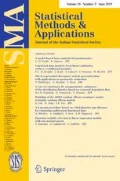Abstract
This article provides a concise overview of the main mathematical theory of Benford’s law in a form accessible to scientists and students who have had first courses in calculus and probability. In particular, one of the main objectives here is to aid researchers who are interested in applying Benford’s law, and need to understand general principles clarifying when to expect the appearance of Benford’s law in real-life data and when not to expect it. A second main target audience is students of statistics or mathematics, at all levels, who are curious about the mathematics underlying this surprising and robust phenomenon, and may wish to delve more deeply into the subject. This survey of the fundamental principles behind Benford’s law includes many basic examples and theorems, but does not include the proofs or the most general statements of the theorems; rather it provides precise references where both may be found.
Similar content being viewed by others
References
Benford F (1938) The law of anomalous numbers. Proc Am Philos Soc 78(4):551–572
Berger A, Hill TP (2011) Benford’s law strikes back: no simple explanation in sight for mathematical gem. Math Intell 33(1):85–91
Berger A, Hill TP (2015) An introduction to Benford’s law. Princeton University Press, Princeton
Berger A, Hill T P, Rogers E (2009) Benford Online Bibliography. www.benfordonline.net. Accessed 17 April 2020.
Berger A, Twelves I (2018) On the significands of uniform random variables. J Appl Probab 55:353–367
Dubins L E, Freedman D A (1967) Random distribution functions. In Proc. Fifth Berkeley Sympos. Math. Statist. and Probability (Berkeley, Calif., 1965/66), Vol. II: Contributions to Probability Theory, Part 1, pp. 183–214. University of California Press, Berkeley
Hill TP (1995) A statistical derivation of the significant-digit law. Statist Sci 10(4):354–363
Miller SJ (ed) (2015) Benford’s Law: theory and applications. Princeton University Press, Princeton
Newcomb S (1881) Note on the frequency of use of the different digits in natural numbers. Am J Math 4(1–4):39–40
Nigrini MJ (2012) Benford’s law: applications for forensic accounting, auditing, and fraud detection. Wiley, Hoboken
Acknowledgements
The first author was partially supported by an NSERC Discovery Grant. Both authors are grateful to the Joint Research Centre of the European Commission for the invitation to speak at their Cross-domain conference on Benford’s Law Applications in Stresa, Italy in July 2019, and especially to the organizers of that conference, Professors Domenico Perrota, Andrea Cerioli, and Lucio Barabesi for their warm hospitality. They also wish to thank two anonymous referees for several thoughtful comments and suggestions.
Author information
Authors and Affiliations
Corresponding author
Additional information
Publisher's Note
Springer Nature remains neutral with regard to jurisdictional claims in published maps and institutional affiliations.
Rights and permissions
About this article
Cite this article
Berger, A., Hill, T.P. The mathematics of Benford’s law: a primer. Stat Methods Appl 30, 779–795 (2021). https://doi.org/10.1007/s10260-020-00532-8
Accepted:
Published:
Issue Date:
DOI: https://doi.org/10.1007/s10260-020-00532-8




